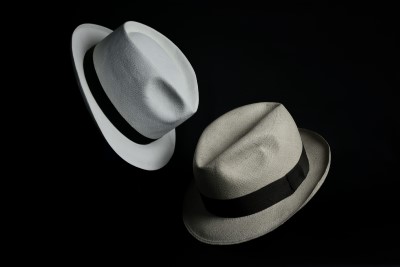Le chapeau Panama, avec son allure élégante et son histoire riche, est bien plus qu’un simple accessoire de mode. Originaire d’Équateur, ce chapeau a traversé les siècles et les frontières, devenant un symbole de raffinement et un ambassadeur de l’artisanat équatorien.
Histoire et Origines

Malgré son nom, le chapeau Panama est profondément ancré dans l’héritage culturel de l’Équateur. Son histoire commence bien avant l’ère moderne, avec des preuves de son usage remontant à la culture Valdivia vers 4000 av. J.-C. Reconnu pour sa finesse et sa résistance, ce chapeau est depuis son origine tissé à partir de la “paja toquilla“, une fibre extraite du palmier Carludovica palmata.
Au XVIIe siècle, les espagnols impressionnés par la finesse du tissage, font alors appel à l’habileté de ces artisans pour réaliser les toques traditionnelles des religieuses (tocas), donnant ainsi naissance au terme “toquilla”.
Mais c’est au début XXe siècle qu’ils gagnent en popularité. Lors de la construction du canal de Panama, les ouvriers adoptent ce chapeau pour se protéger du soleil brûlant, ce qui contribue à populariser son nom erroné. La visite de Théodore Roosevelt sur le chantier du canal en 1906, chapeau sur la tête, a immortalisé le “Panama hat” dans l’imaginaire mondial.
Fabrication Artisanale

La fabrication d’un authentique chapeau Panama est un art qui demande précision et patience. Le tressage commence par la rosace au sommet de la calotte, un travail si méticuleux que les modèles les plus haut de gamme peuvent nécessiter jusqu’à dix mois de tissage. Le processus complet illustre un savoir-faire transmis de génération en génération, faisant de chaque chapeau une pièce unique, ce qui explique pourquoi certains chapeaux de peuvent coûter plusieurs dizaines de milliers d’euros.
Les chapeaux Panama se distinguent par trois principaux types de tressage : Montecristi, Brisa, et Cuenca, chacun offrant différents degrés de finesse et de styles. Les plus hauts de gamme, les Montecristi, sont célèbres pour leur tressage extrêmement fin et dont le tissage est si serré qu’ils en deviennent imperméables.
Reconnaissance et Patrimoine

En 2012, l’UNESCO a reconnu le savoir-faire équatorien dans la fabrication des chapeaux Panama en l’inscrivant au patrimoine culturel immatériel de l’humanité. Cette reconnaissance souligne l’importance de préserver cette tradition artisanale non seulement pour sa valeur esthétique mais aussi pour son importance culturelle et économique.
Aujourd’hui, le chapeau Panama est plus qu’un couvre-chef. Il est un symbole de la richesse culturelle et artisanale de l’Équateur, représentant un mélange unique de tradition et de style. C’est un produit de luxe qui attire toujours autant les amateurs de mode du monde entier, en étant devenu par exemple un attribut lié à des évènements emblématiques, notamment du tournoi de tennis de Roland-Garros, puis plus tard de celui de Wimbledon, où il est porté par les spectateurs les jours de soleil.
Notre article : Baños de Agua Santa, Le Charme Caché de l’Équateur
Avec cette histoire riche et cette reconnaissance mondiale, le chapeau Panama continue de fasciner et d’inspirer, un exemple remarquable de la manière dont un objet artisanal puisant ses origines dans une histoire profonde peut devenir une icône de mode internationale intemporelle.







